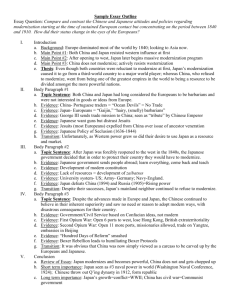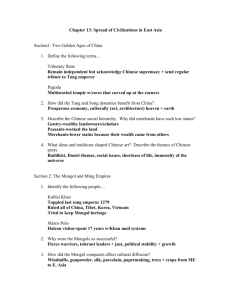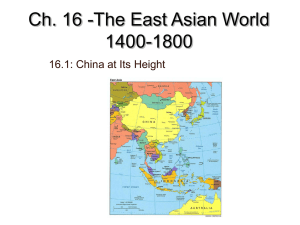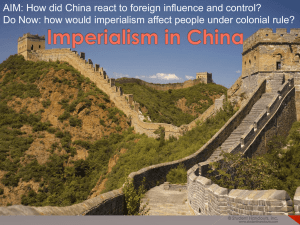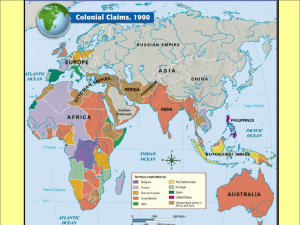Question: Compare and contrast the Chinese and Japanese
advertisement
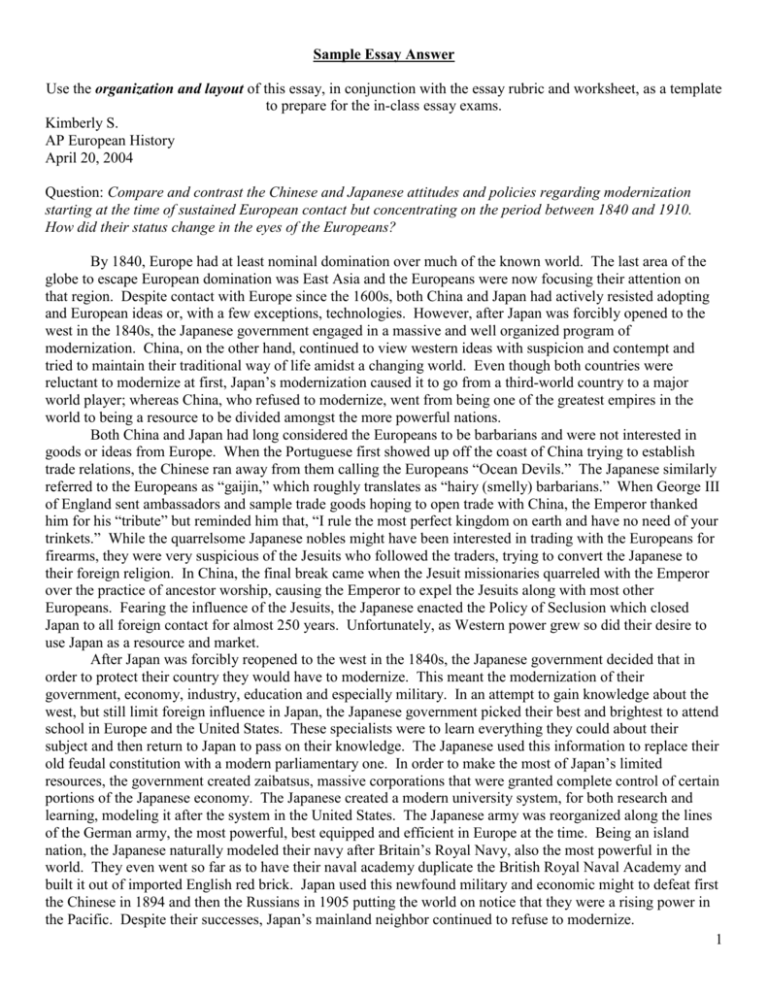
Sample Essay Answer Use the organization and layout of this essay, in conjunction with the essay rubric and worksheet, as a template to prepare for the in-class essay exams. Kimberly S. AP European History April 20, 2004 Question: Compare and contrast the Chinese and Japanese attitudes and policies regarding modernization starting at the time of sustained European contact but concentrating on the period between 1840 and 1910. How did their status change in the eyes of the Europeans? By 1840, Europe had at least nominal domination over much of the known world. The last area of the globe to escape European domination was East Asia and the Europeans were now focusing their attention on that region. Despite contact with Europe since the 1600s, both China and Japan had actively resisted adopting and European ideas or, with a few exceptions, technologies. However, after Japan was forcibly opened to the west in the 1840s, the Japanese government engaged in a massive and well organized program of modernization. China, on the other hand, continued to view western ideas with suspicion and contempt and tried to maintain their traditional way of life amidst a changing world. Even though both countries were reluctant to modernize at first, Japan’s modernization caused it to go from a third-world country to a major world player; whereas China, who refused to modernize, went from being one of the greatest empires in the world to being a resource to be divided amongst the more powerful nations. Both China and Japan had long considered the Europeans to be barbarians and were not interested in goods or ideas from Europe. When the Portuguese first showed up off the coast of China trying to establish trade relations, the Chinese ran away from them calling the Europeans “Ocean Devils.” The Japanese similarly referred to the Europeans as “gaijin,” which roughly translates as “hairy (smelly) barbarians.” When George III of England sent ambassadors and sample trade goods hoping to open trade with China, the Emperor thanked him for his “tribute” but reminded him that, “I rule the most perfect kingdom on earth and have no need of your trinkets.” While the quarrelsome Japanese nobles might have been interested in trading with the Europeans for firearms, they were very suspicious of the Jesuits who followed the traders, trying to convert the Japanese to their foreign religion. In China, the final break came when the Jesuit missionaries quarreled with the Emperor over the practice of ancestor worship, causing the Emperor to expel the Jesuits along with most other Europeans. Fearing the influence of the Jesuits, the Japanese enacted the Policy of Seclusion which closed Japan to all foreign contact for almost 250 years. Unfortunately, as Western power grew so did their desire to use Japan as a resource and market. After Japan was forcibly reopened to the west in the 1840s, the Japanese government decided that in order to protect their country they would have to modernize. This meant the modernization of their government, economy, industry, education and especially military. In an attempt to gain knowledge about the west, but still limit foreign influence in Japan, the Japanese government picked their best and brightest to attend school in Europe and the United States. These specialists were to learn everything they could about their subject and then return to Japan to pass on their knowledge. The Japanese used this information to replace their old feudal constitution with a modern parliamentary one. In order to make the most of Japan’s limited resources, the government created zaibatsus, massive corporations that were granted complete control of certain portions of the Japanese economy. The Japanese created a modern university system, for both research and learning, modeling it after the system in the United States. The Japanese army was reorganized along the lines of the German army, the most powerful, best equipped and efficient in Europe at the time. Being an island nation, the Japanese naturally modeled their navy after Britain’s Royal Navy, also the most powerful in the world. They even went so far as to have their naval academy duplicate the British Royal Naval Academy and built it out of imported English red brick. Japan used this newfound military and economic might to defeat first the Chinese in 1894 and then the Russians in 1905 putting the world on notice that they were a rising power in the Pacific. Despite their successes, Japan’s mainland neighbor continued to refuse to modernize. 1 Despite the advances made in Europe and Japan, the Chinese continued to believe in their inherent superiority and saw no need or reason to adopt modern ways, with disastrous consequences for their country. China’s government, civil service and military were organized around the ancient philosophies of Confucius, not on modern principals of science or organization. Beginning in the 1850s, the Chinese were forced to accept a series of humiliating treaties which were forced on them by the Europeans. Their loss in the first Opium War forced the Chinese to accept a treaty that ceded Hong Kong to England, permanently opened six ports to English trade and granted all English subjects extraterritoriality in all the treaty ports. Their defeat in the Second Opium War opened eleven more ports to the Europeans, allowed European merchants access to the Yangtze River, opened China to Christian missionaries and allowed the Europeans to establish a permanent presence in Beijing. After China suffered a humiliating defeat at the hands of the Japanese in 1894, the young Chinese Emperor attempted to begin a modest program of reform and modernization. However, this threatened the traditional power structure of the Chinese court and the Emperor was deposed in a palace coup lead by his aunt, the Empress Dowager Xi Ci. Because of the chaos caused by the coup, the Chinese government was not able to maintain order during the peasant uprising known as the Boxer Rebellion. The rebellion gave the European powers the chance to intervene with their militaries, especially when the Boxers attacked the European embassies in Beijing. In 1901, the Chinese were forced to sign the Boxer Protocols which allowed the Europeans to station troops in Beijing and along the railway line between Beijing and the ocean. It also forced the Chinese to pay an indemnity that was equal to one ounce of silver for every man, woman and child in China. It was obvious that China was now simply viewed as a carcass to be carved up by the Europeans and Japanese. These differences in modernization policies had important but divergent effects on China and Japan. The Japanese overcame their resistance to outside ideas and set out on a well organized course of modernization and within fifty years were seen as a major power. China, once seen as the greatest empire in the world, refused to modernize and fell victim to its more advanced competitors. In 1921, the major world powers met in Washington to discuss naval arms limitations. At this meeting, Japan was tacitly acknowledged as the third most powerful naval power in the world. The Chinese people, convinced that their government had failed them, staged a revolution in 1912 that overthrew the Q’ing dynasty and turned China into a republic. Unfortunately, the Japanese continued to follow the European model. When Japan ran out of natural resources, they did what the Europeans always had: conquer another country and take their resources. This brought Japan into conflict with other colonial powers, raising the tensions in the Pacific that eventually led to Japan’s involvement in World War II. In China, the Republic soon degenerated into a multi-sided civil war that pit the ruling government against the Chinese Communist Party and various ambitious warlords. The Communists had the ultimate victory in 1948, turning China into a dictatorship but finally allowing it to begin to modernize. 2
